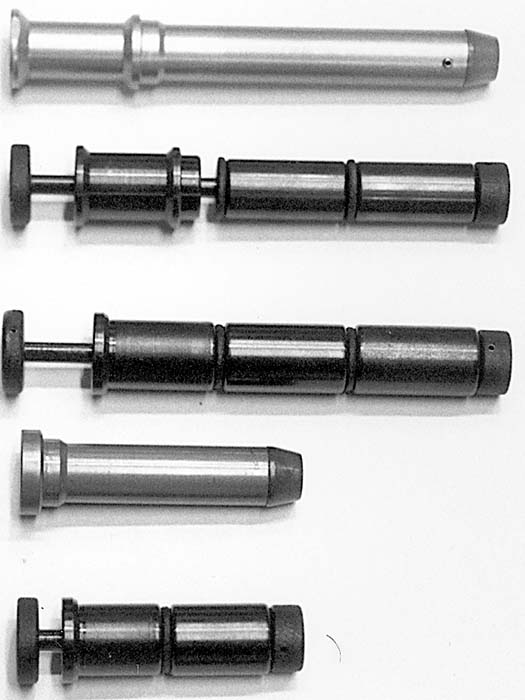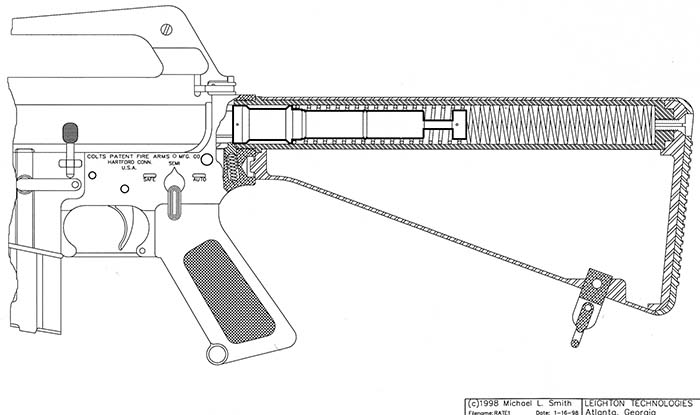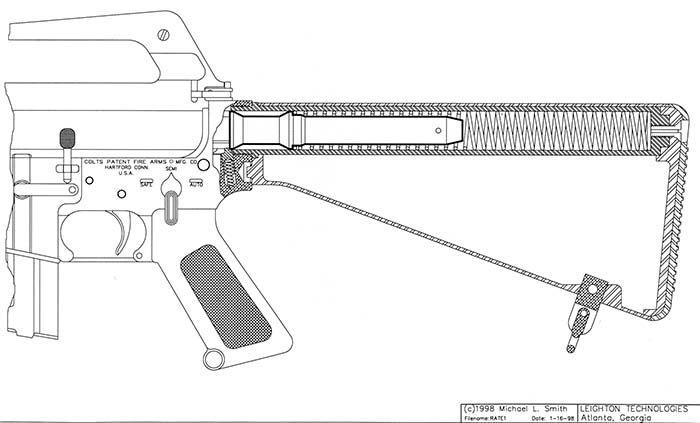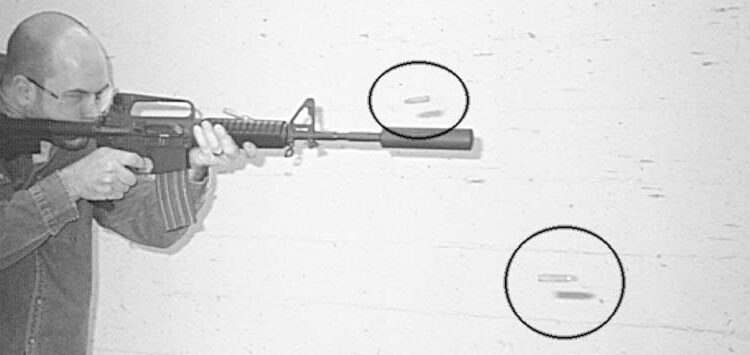By Chris McLoughlin
One of Kevin Brittingham’s adjunct ventures in the field of special weapons is the manufacture and marketing of a cyclic rate reducer for Colt M16s and clones of that rifle. Operating under the banner of Advanced Armament Corporation (221 W. Crogan Street, Dept. GWLE, Lawrenceville, Georgia 30045; Tel 770 277 4946; Fax 770 963 6556), Brittingham gives full credit for the design and development of the device to Maxwell Atchisson, and all parties to the device are properly protected by U.S. Letters of Patent. Atchisson, whose renown is as an inventor in the small arms field, was formerly associated with Military Armament Corporation of Marietta, Georgia. There he worked with Gen. Mitchell L. WerBell, III who is credited with the development of the SIONICS sound suppressor which he originally patented for the M16 and later for the M10 and M11 submachine guns that were designed by Gordon Ingram. It is thought that Atchisson has more than a dozen different inventions for military small arms including the M16.

The ACC cyclic rate reducer system is supplied in kit form and includes all the parts necessary for the transition including a well detailed instruction book with step-by-step installation photos. The procedure involves a simple buffer replacement, and it can be accomplished in a matter of minutes without any gunsmithing talents, extra hands, or high priced tools. Once completed, there is no permanent alteration to the rifle, and it can be returned to its original configuration.
The recent rediscovery of the .223 round for use by law enforcement’s special teams is complimented by the introduction of the AAC buffer unit device. The kit gives the shooter complete controllability of the weapon when fired in the full automatic mode. Muzzle climb is virtually completely eliminated when the weapon is held correctly, and this in turn adds to enhanced aimed fire accuracy in dynamic entry actions, hostage recovery operations, and close quarter battle situations. Training costs, realized in ammunition and in time on the range, are considerably reduced making the device practical for every weapon in a department arsenal.

In a firing demonstration session, Brittingham used a conventional Colt M16 rifle, but with a Gemtech sound suppressor fitted to it. It is known that properly made suppressors do not effect the normal mechanical function of a weapon when fired in the full automatic mode, but they will increase, albeit only slightly, the weapon’s cyclic rate. The ACC cyclic reducer system, working at a counterpoint to the Gemtech suppressor in this phase, performed exactly as it should – as did the suppressor. The M16’s cyclic rate was slowed to the point that the ejected brass could be easily counted as they almost lazily sailed out of the gun’s ejection port. It is also notable that the ACC device will not foster weapon malfunctions in inclement weather or other environmentally hostile environments.

Atchisson, in his genius, engineered the devices so that they would be stock specific, not caliber specific. The buffer system unit will operate just as well with a 9mm or 40S&W, for example, in guns with conversion kits, as with the conventional .223. A variety of new, commercially manufactured foreign and domestic ammunition was used in AAC’s testing and development of the device for .223 guns, and Winchester’s USA 115gr 9mm was used exclusively for that chambering. The rounds-per-minute results stated in the company’s literature were obtained with a P.A.C.T.-MkIV Championship Timer. There are three types available to accommodate all needs. The SS (Super Slow) reduces cyclic rate to approximately 475 rpm, and the SM (Standard Military) drops the rate to about 600rpm; both of these models are for standard stock models. The CS (Collapsible Stock) unit, which includes a replacement buffer spring and an insertion/extraction tool, takes the cyclic rate down to about 650rpm. Because many of M-16s on the market and in private collections are conversions of semi-automatic rifles and are not original select fire weapons built to military specifications, AAC does not guarantee that their cyclic rate reducer will function flawlessly in all rifles. For that reason the company offers for thirty days a money-back guarantee if the shooter is not completely satisfied with the device. Priced at $149.95 (plus $8.50 for Federal Express shipping), the cost of the kit can often be recovered by law enforcement agencies in a one-thousand round training session.
| This article first appeared in Small Arms Review V2N6 (March 1999) |












